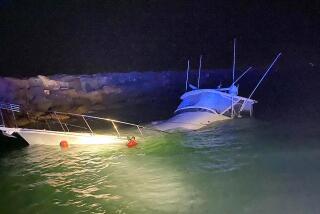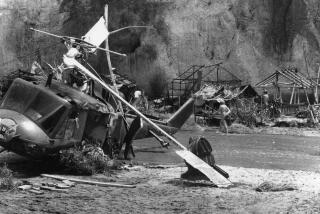Boat Driver Faces Second Trial in Fatal Crash
- Share via
Virl Earles doesn’t understand why prosecutors are once again trying to convict him.
Earles, charged with involuntary manslaughter in the deaths of five passengers who died when he drove a motorboat into a concrete buoy in Seal Beach two years ago, had his first trial end in a hung jury.
“This is terrible,” Earles said bitterly when he learned in February that he’d be tried again. “Why do we have to go through this again?”
In January, a jury deadlocked on a 9-3 vote for acquittal of the 31-year-old Seal Beach construction worker, forcing Superior Court Judge Jean Rheinheimer to call a mistrial.
Deputy Dist. Atty. John Conley recognized then it would be difficult to ever convict Earles. In fact, Conley said at the time he would probably not seek a second trial unless he could come up with some new evidence. He didn’t.
But Earles is back in Rheinheimer’s court this week, facing the same charges at a second trial. Opening statements and the beginning of testimony are scheduled for Monday.
Better Case
Conley has an answer for Earles about why he’s going after him again.
“We don’t consider it an accident,” Conley said.
Also, while the evidence will be pretty much the same, Conley said he thinks he can put on a better case because of long discussions he has had with the first jurors.
“A lot of things were unclear to them,” Conley said. “I think this time we can clear up some of the questions a little better.”
Earles was driving the six-seat boat at a high rate of speed on a dark morning Oct. 28, 1984, with eight passengers aboard.
The group had partied at Peter’s Landing in Huntington Beach and most were in Halloween costumes when they decided to take a drive out to view the Queen Mary in Long Beach. They left the harbor and headed through Anaheim Bay toward Long Beach.
According to Earles, on the return trip he misjudged the location of the safe boating channel. Within seconds after passing the jetty walls guarding the bay, the boat crashed head-on with the 11-foot wide buoy, used to moor Navy vessels.
Five Killed Instantly
Five of the boaters were killed instantly. All four of the survivors were seriously injured. Two of them managed to crawl up onto the buoy. Despite their own injuries, they held Earles’ head out of the water as he lapsed in and out of consciousness. The fourth survivor swam to shore for help despite a broken pelvis.
Earles’ attorney, Gary Pohlson, told the first jury that “it was a tragic accident, but that’s all it was--an accident.” The majority on the jury agreed.
The key to Earles’ defense was his claim that a temporary jetty light, located in a different place from the regular light, had thrown him off course.
Conley contended at the first trial that Earles knew the speed limit in the bay was 5 m.p.h., yet was driving at a high rate of speed--30 m.p.h. by Earles’ own admission to police, and closer to 40 m.p.h. by the prosecution’s calculations.
Conley also argued that there were no life jackets in the boat, which was overloaded with passengers. Earles was criminally negligent because he knew he was driving the boat under unsafe conditions, Conley said.
Blood Alcohol Level
But it was evidence that Conley could not produce at the first trial that had helped lead to Earles being charged at all. His blood alcohol was slightly above the amount that would have led to drunk-driving charges had he been in a vehicle.
The same standard does not apply directly to boat drivers, but Conley was ready to bring on expert witnesses to testify that anyone with that much alcohol could not drive a boat safely.
But a foul-up occurred. Police officials did not get Earles’ permission before taking a blood test (he was too seriously injured to talk to them). Only people under arrest can be tested without their permission. Police officials thought he had been arrested, but were mistaken.
The alcohol evidence was thrown out during Earles’ preliminary hearing a year ago, and is lost to prosecutors forever. Pohlson said later it had little significance anyway. And Conley said he wasn’t sure how important it was.
But when the information was printed in a Los Angeles Times story during the first trial, Judge Rheinheimer took time to poll the jury to make sure no one had read about it. Also, it was discovered after the mistrial was declared that one of the jurors had learned about the alcohol evidence anyway--one of the three who had voted guilty.
Killed in the boat crash were Anthony Sutton, 27, Ronald Myers, 22, and John Bakos, 22, all of Seal Beach; Kathy Weaver, 24, of Laguna Beach, and Patricia Hulings, 20, of Downey.
Earles is still recovering from injuries he suffered in the accident. The other survivors--who all testified on his behalf at the first trial--are Carol Kemble, 25, of Laguna Beach, Ernest Chavez, 25, of Bakersfield, and Stephen Brennan, 24, of Huntington Beach. It was Brennan who swam to shore for help.
More to Read
Sign up for Essential California
The most important California stories and recommendations in your inbox every morning.
You may occasionally receive promotional content from the Los Angeles Times.













